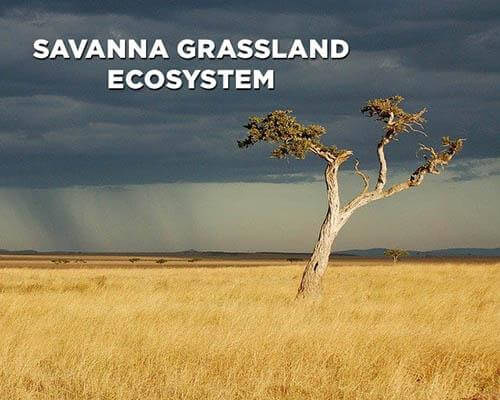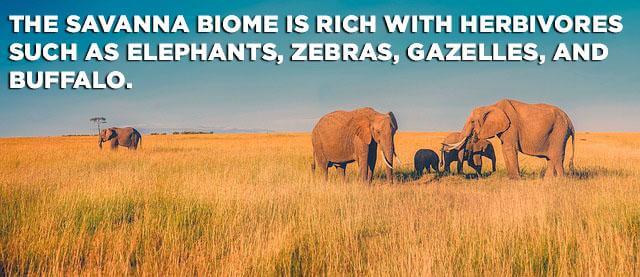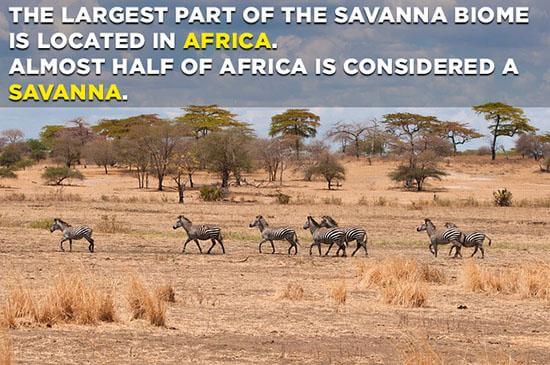Easy Draweings of the Savanna Ecosystem Animals
Savanna Ecosystem
Savanna is an ecosystem with a huge grassland area spread in acres. It is mostly known as a dry region, but it is wet at the same time. Well, the savanna is a natural landform with grasses all around providing a perfect environment, especially for grazing animals.

Each ecosystem, whether it is rainforest or savanna, has its importance in maintaining proper balance in the environment. Many people love to watch wildlife on the discovery channel; Jungle safari at Savanna grassland is an ideal amusement for them to experience wildlife personally.
Table of Contents
- 1 Savanna Grassland Definition
- 2 Savanna Ecosystem Characteristics
- 2.1 Savanna Grassland Animals
- 2.2 Savanna Grassland Plants
Savanna Grassland Definition
A terrestrial habitat where plants and animals are living together in an open area covered with grasses and some scattered bushes & trees is known as Savanna grassland ecosystem.
It can also be defined as a "woodland-grassland ecosystem" where trees and grasses are scattered usually in tropical or subtropical regions and have seasonal rainfall.
Savanna grasslands are located within 30 degrees of Earth's equator usually found between tropical rainforest & deserts.
There are many different types of Savanna ecosystems found on the Earth, depending on different locations such as Serengeti Plains of Tanzania, Savanna of Venezuela, the vast Acacia Plains of East Africa, the Australian Savanna, etc.
Savanna Ecosystem Characteristics

- Savanna Grassland Location
Grasses cover savanna, hence called as grassland. However, you can see a few numbers of trees scattered here and there in the grassland area.
Savanna grassland is a vast area spread almost half the area of Africa. Apart from Africa, Savanna is also covered in some parts of Australia, South America, and India.
- Climate at Savanna
Climate is an essential characteristic of any ecosystem. The climate of the Savanna ecosystem is quite warm, and the temperature ranges between 68 degrees Fahrenheit and 86 degrees Fahrenheit.
Savanna receives moderate rainfall up to 10 to 30 inches annually; This is why savanna experience dry season almost all year round. Savanna experience wet summer season (6 to 8 months) and dry winter season (4 to 6 months).
The plants & trees at Savanna ecosystem mostly lose their leaves or sometimes die due to adverse climatic conditions during the dry season.
- Savanna grassland Soil & Nutrients
The soil form at Savanna ecosystem is very poor in terms of fertility. As the nutrients found in the soil are very less, hence it is poor in quality. However, some amounts of nutrients are found in the soil surface due to the decaying of organic matter.
Poor quality soil is one of the major reasons for restricted vegetation in the Savanna ecosystem.
The soil found in the Savanna ecosystem appears red due to the high amount of iron present in it.
- Fires in Savanna ecosystem
Fire in Savanna grassland is quite often to happen. In dry season burning of the grasslands at Savanna ecosystem is common to see.
When lightning strikes, the grassland in savanna catches fire, especially in the dry season. The fire burns the old dry grass in savanna that allows fresh grass to grow on the land.
Many plants can survive in case of fire because of their strong root system, which helps them to regrow faster after the fire.
Some trees with thick bark also win to survive in the adverse conditions during grassland fire.
As far as the animals are concerned, most of the animals escape from the place of fire. Some other animals burrow deep inside the ground to get protection against fire. Unfortunately, the insects mostly die in considerable numbers in grassland ignition.
- Flora and Fauna at Savanna Ecosystem
Savanna is very poor in terms of vegetation with fewer trees, bushes, and huge grasslands. Less rainfall & dry climate is the primary reason for poor flora at Savanna ecosystem.
On the other hand, the savanna is quite rich in terms of the fauna of this region. It is a home for a wide variety of animal species starting from carnivorous, herbivorous, omnivorous, to scavengers, etc.
Savanna Grassland Animals
Savanna ecosystem provides shelter to various species of animals, including mammals, grazing animals, insects, etc. The large size mammals living in the Savanna ecosystem mostly include zebras, buffalo, leopard, elephants, cheetah, giraffes, rhinoceroses, lions, etc.

Other species of animals found in the Savanna ecosystem includes crocodile, meerkats, termites, ostriches, baboons, snakes, antelopes, ants, kangaroos, Aardwolf, African Wild Dog, Black Mamba, Blesbok, Bontebok, Nigriceps Ants, Nile Crocodile, etc.
Savanna ecosystem is also crowded with grazing herbivores that usually lives in a herd. These herbivores rely on their speed to survive against predators; Slow ones unfortunately becomes prey to the predators.
Camouflage is an important characteristic of the predator of the Savanna ecosystem. They camouflaged with the environment to get an easy chance for hunt. The camouflage technique is not only used by the predator for hunting but sometimes also used by prey to hide from predators.
Savanna Grassland Plants
As the name suggests, the savanna is known as grassland due to the insufficient number of trees. The adverse climate of the Savanna ecosystem does not allow flourishing ample vegetation.
The vegetation, including mostly grasses and dispersed trees, has adapted the climatic conditions of the Savanna ecosystem. Only those plant species can survive in the Savanna ecosystem that can resist in hot weather and little water.
Grass at Savanna ecosystem tends to grow rapidly in wet months, whereas in the dry season, the grasses become brown. The grass is comparatively shorter in size due to frequent fire.
Some plants and trees have developed long roots to reach water level underground to survive in dry weather of the Savanna ecosystem.
Some of the common plant species found in the Savanna ecosystem include Baobab, Candelabra Tree, Gum Tree Eucalyptus, Manketti Tree, Umbrella Thorn Acacia, Acacia Senegal, Bermuda Grass, Elephant Grass, Jackalberry Tree, River Bushwillow, Whistling Thorn, etc.
Savanna is an important ecosystem on Earth. We need to conserve this unique ecosystem for our future generation but, most importantly, for the flora & fauna of this region. Savanna grasslands provide habitat to hundreds of migratory bird species and endangered animal species.
The Savanna ecosystem is also a victim of climate change & global warming. As a result, some of the plant and animal species of Savanna grasslands have been extinct or becoming endangered. We need to take initiatives to protect the Savanna ecosystem from saving the plant and animal species that depend on this ecosystem for habitat.
Source: https://www.earthreminder.com/savanna-ecosystem-definition-characteristics/
0 Response to "Easy Draweings of the Savanna Ecosystem Animals"
Enregistrer un commentaire